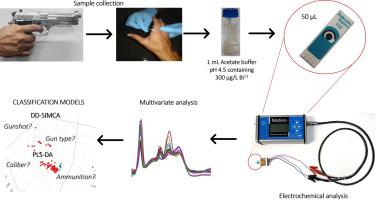当前位置:
X-MOL 学术
›
Forensic Chem.
›
论文详情
Our official English website, www.x-mol.net, welcomes your feedback! (Note: you will need to create a separate account there.)
Screen-printed electrode modified with bismuth film and chemometric techniques for on-site detection and classification of gunshot residues
Forensic Chemistry ( IF 2.7 ) Pub Date : 2024-02-20 , DOI: 10.1016/j.forc.2024.100563 Leandro Paulo da Silva , Lívia Rodrigues e Brito , Ramon Bezerra de Souza , Carlos Fernando Monteiro Pessoa Filho , Vagner Bezerra dos Santos , Licarion Pinto
Forensic Chemistry ( IF 2.7 ) Pub Date : 2024-02-20 , DOI: 10.1016/j.forc.2024.100563 Leandro Paulo da Silva , Lívia Rodrigues e Brito , Ramon Bezerra de Souza , Carlos Fernando Monteiro Pessoa Filho , Vagner Bezerra dos Santos , Licarion Pinto

|
The analysis of gunshot residues (GSR) is important for forensic science to help understand what happened in a crime scene. Many works on this have been published; however, there are a number of questions that remain. An analytical method should ideally respond to these questions: 1 Can the residue from a shooting or the analysis present a false positive? 2. Is it possible to identify the gun used in a shooting and information about it such as caliber and type of ammunition used? An analysis, as well, must be precise, easy to use, reproducible and allowable on-site. To achieve these requirements, voltammograms registered on a portable potentiostat, and chemometrics analysis were used. Electroanalytical techniques provide meaningful chemical information about a sample. Chemometric tools make it possible to build models to identify even small differences and respond to these questions with data. A total of 90 GSR samples were collected with the help of the Institute of Criminalistics in the state of Pernambuco, Brazil. The GSR were taken from 3 types of firearms, 2 of them with distinct ammunition. To assess the risk of false positives, 45 non-shooting samples were analyzed. The model constructed achieved a classification accuracy of 100 % to respond to the question of false positives. There was an accuracy rate of over 85 % for the second question, of identifying information about the weapon. A blind test was performed and used to prove that the electroanalytical-chemometrics methodology was useful and effective for GSR forensic investigators, enabling the emission of reliable reports, and contributing to faster processing of legal proceedings.
中文翻译:

铋膜修饰的丝网印刷电极和化学计量技术用于枪击残留物的现场检测和分类
枪击残留物 (GSR) 的分析对于法医科学非常重要,有助于了解犯罪现场发生的情况。许多这方面的著作已经出版;然而,仍然存在一些问题。理想的分析方法应回答以下问题: 1 枪击事件或分析的残留物是否会出现误报? 2. 是否可以识别枪击事件中使用的枪支以及有关枪支的信息,例如所用弹药的口径和类型?分析还必须精确、易于使用、可重复且可在现场进行。为了满足这些要求,使用了在便携式恒电位仪上记录的伏安图和化学计量学分析。电分析技术提供有关样品的有意义的化学信息。化学计量工具可以构建模型来识别甚至微小的差异,并用数据回答这些问题。在巴西伯南布哥州犯罪学研究所的帮助下,总共收集了 90 个 GSR 样本。 GSR 取自 3 种类型的枪支,其中 2 种使用不同的弹药。为了评估误报风险,对 45 个非射击样本进行了分析。构建的模型实现了 100% 的分类准确率,解决了误报问题。第二个问题(武器信息识别)的准确率超过 85%。进行盲测并用于证明电分析化学计量学方法对于 GSR 法医调查人员来说是有用且有效的,能够生成可靠的报告,并有助于更快地处理法律诉讼。
更新日期:2024-02-20
中文翻译:

铋膜修饰的丝网印刷电极和化学计量技术用于枪击残留物的现场检测和分类
枪击残留物 (GSR) 的分析对于法医科学非常重要,有助于了解犯罪现场发生的情况。许多这方面的著作已经出版;然而,仍然存在一些问题。理想的分析方法应回答以下问题: 1 枪击事件或分析的残留物是否会出现误报? 2. 是否可以识别枪击事件中使用的枪支以及有关枪支的信息,例如所用弹药的口径和类型?分析还必须精确、易于使用、可重复且可在现场进行。为了满足这些要求,使用了在便携式恒电位仪上记录的伏安图和化学计量学分析。电分析技术提供有关样品的有意义的化学信息。化学计量工具可以构建模型来识别甚至微小的差异,并用数据回答这些问题。在巴西伯南布哥州犯罪学研究所的帮助下,总共收集了 90 个 GSR 样本。 GSR 取自 3 种类型的枪支,其中 2 种使用不同的弹药。为了评估误报风险,对 45 个非射击样本进行了分析。构建的模型实现了 100% 的分类准确率,解决了误报问题。第二个问题(武器信息识别)的准确率超过 85%。进行盲测并用于证明电分析化学计量学方法对于 GSR 法医调查人员来说是有用且有效的,能够生成可靠的报告,并有助于更快地处理法律诉讼。



























 京公网安备 11010802027423号
京公网安备 11010802027423号